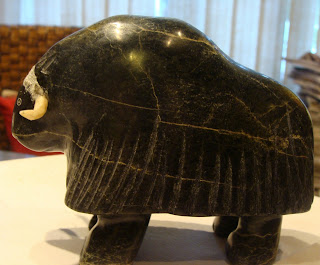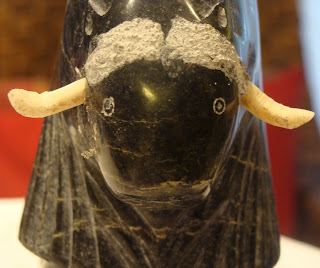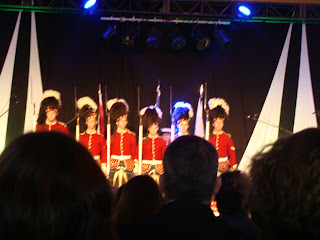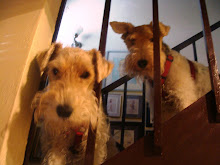
Whenever our mom goes on one of her "business trips," we both know she'll be bringing lots of stuff home with her. Sometimes it's treats for us. Sometimes new collars. Sometimes a stuffie or two. But most often it's something that goes on a wall (except we're pretty much out of wall space). Or something that goes on a shelf or a table (except we're pretty much out of empty flat surfaces too.). Or it's something that goes into a book case (30 pounds came back from Vancouver... and there's not much space to spare in the book cases either).
So we were kind of holding our breath when she came back from Nova Scotia. A few books, check. A calendar, check. A few prints, check. But nothing prepared us for this:


What is it you're probably wondering ?
According to mom, it's a musk ox sculpted by an Inuit artist. Just what we needed, eh?

Muskoxen *
Should you be lucky enough to see the trademark shaggy coat of the muskox (umingmak), you may feel like you've been transported back in time. Indeed, it's easy to imagine continental ice sheets covering much of North America — as they did some 18,000 years ago — when in the company of the "bearded one."
Unlike the caribou, which prefer slow-growing lichens, muskoxen depend largely on grasses and sedges that recover relatively quickly from heavy grazing. In the summer, these herbivores may be seen in river valleys, along lake shores and near damp meadows. If grasses and sedges become unavailable in winter, muskoxen move onto ridges and hilltops to feed on willows and other plants. They are often seen in groups of 10 to 20, depending on season and location. When threatened, muskoxen form defensive circles with adults facing outwards and calves in the centre. This behavior, while effective against four-legged predators, makes muskoxen easy prey for human hunters.
Large numbers of muskoxen roamed the tundra of Nunavut before the arrival of European and Canadian traders. The subsequent market for meat and hides reduced their populations to dangerously low numbers until Canada protected them in 1917. Since then, muskoxen have recovered and recolonized most of their historic range so that closely regulated harvesting can be sustained. Today, Nunavut holds most of Canada's muskoxen, with about 60,000 animals. The species occupies much of Nunavut, except for the eastern mainland and Baffin Island.
Inuit do not usually prefer muskoxen over caribou, although the meat can be delicious and the skins produce warm sleeping robes. Beginning in May, muskoxen shed large quantities of their underfur (qiviut), which can be spun into a luxurious wool. Bulls weigh about 350 kilograms, some 50 kilograms heavier than cows. Muskoxen mate in the summer; bulls can become unpredictable during this period. Do not approach muskoxen too closely, especially if you're not accompanied by an experienced guide. They can be aggressive.
ABOUT THE WOOL²: The Oomingark [as the Inuit call it] is covered all over with "wool", except for it's horns,hooves, lips and nose, with an underlayer of short fine wool for exceptional warmth. Amuch longer outer coat composed of shaggy hair up to 24" in length covers theanimal, hanging nearly to the ground and giving the muskox its mystic appearance.
The coat is generally dark brown or nearly black. About the shoulders it is extremelyshaggy and forms a distinct mane, especially noticeable on bulls. Behind the shoulder is a short white or creamy yellow "saddle". The lower legs have light brown to white "stockings".
* - Reproduced from an article Land Mammals by Marian and Mike Fergusoncontained in the Nunavut Handbook
2 - Reproduced from NWT Wildlife Sketches Series - Muskox of tje Northwest Territories This new guy, who apparently is to make himself at home somewhere up high where we can't reach him, is kind of heavy -- his dense little body weighs about two pounds. And -- this is for Gail and Bertie -- we think he's made of serpentine, one of the rock formations prevalent in parts of Canada. He does have a few Inuit cohorts here from previous forays -- but so far hasn't joined them.We do seem to have one thing in common: musk oxen have double coats, just like we do. But is that enough to be BFFs?
So far, he hasn't a name -- although Mak, short for umingmak, the Inuit word for musk ox, is a starter. And he seems rather staid (no, Lacie, we're not sure if he dates or not). But we can't help but wonder: who needs this?
 When you have one of these???
When you have one of these???  And one of these???
And one of these???

Just askin'.
Jake and Just Harry






 and their lovely mom, Elaine -- and then just a few weeks ago, Halifax and other parts of Nova Scotia. They -- and so we -- think Canada is a very cool place and we hope we get to visit it someday soon .
and their lovely mom, Elaine -- and then just a few weeks ago, Halifax and other parts of Nova Scotia. They -- and so we -- think Canada is a very cool place and we hope we get to visit it someday soon . 





 When you have one of these???
When you have one of these???  And one of these???
And one of these???




 And some pay tribute to the fishing industry that is still a mainstay of the community.
And some pay tribute to the fishing industry that is still a mainstay of the community.


 And then we found Peggy's Cove, with its stark lighthouse and breathtaking granite boulders. The town dates back to 1811 and, at its peak, was home to 300 people.Today, no more than 50 people live here -- but a steady flow of tourists, artists, and photographers keeps the community going.
And then we found Peggy's Cove, with its stark lighthouse and breathtaking granite boulders. The town dates back to 1811 and, at its peak, was home to 300 people.Today, no more than 50 people live here -- but a steady flow of tourists, artists, and photographers keeps the community going. These are a few of the bare houses that nestle against the granite boulders, which are reputed to be some 40 million years old!
These are a few of the bare houses that nestle against the granite boulders, which are reputed to be some 40 million years old!

 And this is the lighthouse. The Canadian Navy used it as a radio station in World War II. It's now automated and doubles as a post office in the summer.
And this is the lighthouse. The Canadian Navy used it as a radio station in World War II. It's now automated and doubles as a post office in the summer.
 she prevailed, and here are the photos that should have accompanied our previous Nova Scotia post.
she prevailed, and here are the photos that should have accompanied our previous Nova Scotia post.
 And this is the outside of the museum -- formally called the Art Gallery of Nova Scotia. This amazing bird is an Inuit sculpture.
And this is the outside of the museum -- formally called the Art Gallery of Nova Scotia. This amazing bird is an Inuit sculpture.  The name of the cafe, Cheapside, is a reference to the past, when the area was known for having less expensive goods for sale. But the cafe inside the gallery is anything but cheap looking -- warm russet walls, black tables and chairs, harlequin tiles on the bar, and dark blue on the ceiling.
The name of the cafe, Cheapside, is a reference to the past, when the area was known for having less expensive goods for sale. But the cafe inside the gallery is anything but cheap looking -- warm russet walls, black tables and chairs, harlequin tiles on the bar, and dark blue on the ceiling.  Among other art, the gallery is known for its collection of Canadian folk artists. One of the most well known is Maud Lewis, a self-taught artist who painted life around her -- and also everything inside her house. The house -- just one room -- has been preserved in the gallery -- along with many of her original paintings. They are just delightful. Check her out on the gallery web site:
Among other art, the gallery is known for its collection of Canadian folk artists. One of the most well known is Maud Lewis, a self-taught artist who painted life around her -- and also everything inside her house. The house -- just one room -- has been preserved in the gallery -- along with many of her original paintings. They are just delightful. Check her out on the gallery web site:  Art is everywhere. Dogdad spotted this trompe l'oeil on a building while they were waiting for a shuttle to take them to the convention site one evening.
Art is everywhere. Dogdad spotted this trompe l'oeil on a building while they were waiting for a shuttle to take them to the convention site one evening.


 The Old Burying Ground is also a touching part of Halifax' history. When mom stopped there, she found both locals looking at gravestones and trying to make out the names as well as tourists imagining what the times were like in the 18th century when the city was founded.
The Old Burying Ground is also a touching part of Halifax' history. When mom stopped there, she found both locals looking at gravestones and trying to make out the names as well as tourists imagining what the times were like in the 18th century when the city was founded.
 The tombstones are weathered and almost impossible to read. Many have images of winged angels above the tributes to departed loved ones.
The tombstones are weathered and almost impossible to read. Many have images of winged angels above the tributes to departed loved ones.
 Just near the cemetary is this striking contrast of the old and the new.
Just near the cemetary is this striking contrast of the old and the new. Ah, but this is a seaport -- and, something mom didn't know until she saw this -- the birthplace of Samuel Cunard.
Ah, but this is a seaport -- and, something mom didn't know until she saw this -- the birthplace of Samuel Cunard. The venue where the convention was held carries his name: the Cunard Centre -- adjacent to the piers where the cruise ships berth, including Pier 21, which was the site of so many immigrant debarkations in the past two centuries.
The venue where the convention was held carries his name: the Cunard Centre -- adjacent to the piers where the cruise ships berth, including Pier 21, which was the site of so many immigrant debarkations in the past two centuries.

 Oops, you're not a prow figure -- and who do you think you're fooling with that camouflage?
Oops, you're not a prow figure -- and who do you think you're fooling with that camouflage? The interesting Maritime Museum pays tribute to centuries of Halifax history and seafarers. This marking buoy is on the street next to the museum
The interesting Maritime Museum pays tribute to centuries of Halifax history and seafarers. This marking buoy is on the street next to the museum  -- which mom will remember for one Cape Breton oyster that was the best oyster she ever ate... just one because so many people were crowding the man shucking them that she had no other choice! Dad, on the other paw, who isn't a raw oyster person, will remember the museum for its lighthouse lenses and other awesome technological exhibits.
-- which mom will remember for one Cape Breton oyster that was the best oyster she ever ate... just one because so many people were crowding the man shucking them that she had no other choice! Dad, on the other paw, who isn't a raw oyster person, will remember the museum for its lighthouse lenses and other awesome technological exhibits. 





 Teddy Tugboat Too takes people on sightseeing tours. And the historic properties, restored with shops and restaurants, are part of the old town.
Teddy Tugboat Too takes people on sightseeing tours. And the historic properties, restored with shops and restaurants, are part of the old town.
 Below is the view from their hotel room -- and the Waterfront Warehouse, which used to be a tugboat repair shop but now serves delicious seafood. On the walls are the names of tug boats and companies that used to serve the area's maritime industry.
Below is the view from their hotel room -- and the Waterfront Warehouse, which used to be a tugboat repair shop but now serves delicious seafood. On the walls are the names of tug boats and companies that used to serve the area's maritime industry.

 But what about the convention, Mom? Didn't you go to Halifax on business?????
But what about the convention, Mom? Didn't you go to Halifax on business????? For the opening session, we were greeted by these very well-clad gentlemen, while more bagpipes echoed on the air.
For the opening session, we were greeted by these very well-clad gentlemen, while more bagpipes echoed on the air.

 Sporn and all...
Sporn and all... The entertainment included the Canadian tenors, who we were not allowed to video -- but they were great. And just like that, it was over.
The entertainment included the Canadian tenors, who we were not allowed to video -- but they were great. And just like that, it was over. But there is more, as we still had a day to really relax before flying home -- so next post will be about the unique towns of Lunenberg and Peggy's Cove...
But there is more, as we still had a day to really relax before flying home -- so next post will be about the unique towns of Lunenberg and Peggy's Cove...














